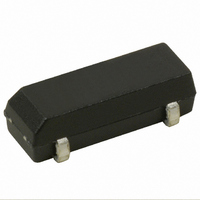SPT2AF-6PF20PPM Seiko Instruments, SPT2AF-6PF20PPM Datasheet - Page 13

SPT2AF-6PF20PPM
Manufacturer Part Number
SPT2AF-6PF20PPM
Description
CRYSTAL 32.768KHZ 6PF SMD
Manufacturer
Seiko Instruments
Series
SP-T2A-Fr
Type
kHz Crystal (Tuning Fork)r
Specifications of SPT2AF-6PF20PPM
Frequency
32.768kHz
Frequency Tolerance
±20ppm
Load Capacitance
6pF
Operating Mode
Fundamental
Operating Temperature
-40°C ~ 85°C
Mounting Type
Surface Mount
Package / Case
4-SOJ, 5.50mm pitch
Size / Dimension
0.343" L x 0.146" W (8.70mm x 3.70mm)
Height
0.098" (2.50mm)
Lead Free Status / RoHS Status
Lead free / RoHS Compliant
Frequency Stability
-
Other names
728-1004-2
Oscillation Circuit Design Precautions
OSCILLATION ALLOWANCE
To ensure stable oscillation, the negative resistance of the circuit should be significantly larger than the equivalent
series resistance (the oscillation allowance is large). Ensure that the oscillation allowance is at least five times as
large as the equivalent series resistance.
Quartz Crystal 2011
FREQUENCY-TEMPERATURE CURVE
Oscillation Allowance Evaluation Method
Add resistor “Rx” to the crystal unit in series and ensure
that the oscillation starts or stops. The approximate
negative resistance of the circuit is the value obtained
by adding the effective resistance “Re” to the maximum
resistance “Rx” when the oscillation starts or stops after
gradually making Rx value larger.
Negative resistance |-R| = Rx + Re
|-R| is a value at least five times as large as the maxi-
mum equivalent series resistance (R
unit.
*Re is the effective resistance value during oscillation.
Re = R
Frequency
Deviation
f/f
0
(x 10 )
1
− 10
− 20
− 30
− 40
− 50
− 60
(1+
0
− 20
− 6
C
C
− 10
0
L
)
2
0
Typ.
Tp=25°C
B=−3.5 x 10 /°C
10
Temperature
20
− 8
30
2
40
1
max.) of the crystal
50
60
70(°C)
Frequency Temperature Characteristics
Frequency temperature characteristics of tuning fork
crystals is shown by negative quadratic curve which
has a peak at 25°C as per left graph.
Please make sure to consider the temperature range
and frequency accuracy you need since magnitude of
frequency variation becomes larger and larger as the
temperature range becomes wider.
[Approximation formula of frequency temperature characteristics]
f_tem=B (T-Ti)
B : Parabolic coefficient
T : Given temperature
Ti : Turnover temperature
Cg
2
Figure 1
Rf
Rx
Rd
Cd
13

















